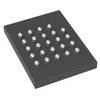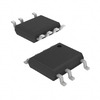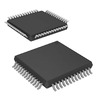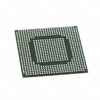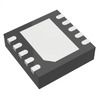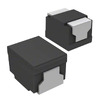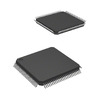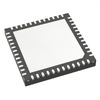MAX30003 Biopotential AFE Guide: Circuit Analysis, Pin Configuration, Datasheet, and AD8232 Comparison
Wearable technology has reshaped how we approach health monitoring, seamlessly merging convenience with clinical-grade functionality. Dominant to this evolution is the MAX30003, a sophisticated biopotential analog frontend tailored for wearables and remote health monitoring devices. It is designed for energy efficiency and precision and enables accurate electrocardiogram (ECG) readings and health insights, making it a popular choice. In this article, we dig into the MAX30003’s advanced features, from its low power consumption and noise-filtering capabilities to its flexible design that supports diverse health-monitoring applications, exploring how it contributes to reliable, continuous patient care and fitness tracking.Catalog
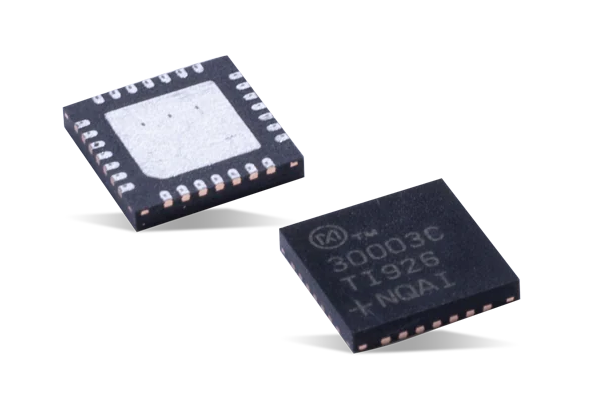
Overview of MAX30003
The MAX30003 is a versatile biopotential analog front-end, ideal for wearable technology that targets both clinical and fitness applications. Designed for power efficiency, it supports prolonged battery life while delivering reliable heart rate and ECG monitoring. With a single biopotential channel, the MAX30003 efficiently measures ECG and heart rate, making it suitable for a wide range of health monitoring needs. This low-power feature extends to an ultra-low-power standby mode, making it ideal for devices requiring continuous monitoring over long durations without frequent recharging.
The device incorporates electrostatic discharge (ESD) protection and electromagnetic interference (EMI) filtering to enhance reliability across varied conditions. These safeguards are useful for devices frequently exposed to electrical disruptions, which can otherwise compromise data integrity. By addressing these issues, the MAX30003 ensures accurate data and device resilience, basic for reliable monitoring in both clinical and fitness environments. This robust protection supports consistent performance, meeting the demands for long-lasting, dependable wearable devices.
Additional features, such as internal lead biasing and automatic lead-off detection, further improve the MAX30003’s usability. With high input impedance, low noise, and customizable gain settings, the device is adaptable to different signal intensities, ensuring precision across applications. Its integrated low-pass and high-pass filters enhance signal clarity, while the high-resolution ADC plays a dangerous role in gathering accurate measurements, dynamic for detailed health data analysis.
Pin Configuration
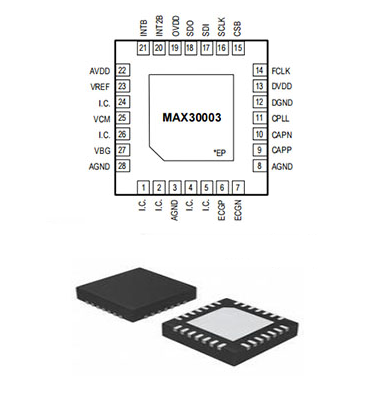
|
Pin Number |
Pin Name |
Description |
|
1, 2, 4, 5, 24, 26 |
I.C. |
Internally Connected. Connect to AGND. |
|
3, 8, 28 |
AGND |
Analog Power and Reference Ground. Connect into the
printed circuit board ground plane. |
|
6 |
ECGP |
ECG Positive Input |
|
7 |
ECGN |
ECG Negative Input |
|
9 |
CAPP |
Analog High-Pass Filter Input. Connect a 1μF X7R
capacitor (CHPF) between CAPP and CAPN to form a 0.5Hz high-pass response in
the ECG channel. |
|
10 |
CAPN |
Analog High-Pass Filter Input. Connect a 1μF X7R
capacitor (CHPF) between CAPP and CAPN to form a 0.5Hz high-pass response in
the ECG channel. |
|
11 |
CPLL |
PLL Loop Filter Input. Connect 1nF COG cap between CPLL
and AGND. |
|
12 |
DGND |
Digital Ground for Both Digital Core and I/O Pad Drivers.
Recommended to connect to AGND plane. |
|
13 |
DVDD |
Digital Core Supply Voltage. Connect to AVDD. |
|
14 |
FCLK |
External 32.768kHz Clock that Controls the Sampling of
the Internal Sigma-Delta Converters and Decimator. |
|
15 |
CSB |
Active-Low Chip-Select Input. Enables the serial
interface. |
|
16 |
SCLK |
Serial Clock Input. Clocks data in and out of the serial
interface when CSB is low. |
|
17 |
SDI |
Serial Data Input. SDI is sampled into the device on the
rising edge of SCLK when CSB is low. |
|
18 |
SDO |
Serial Data Output. SDO will change state on the falling
edge of SCLK when CSB is low. SDO is three-stated when CSB is high. |
|
19 |
OVDD |
Logic Interface Supply Voltage |
|
20 |
INT2B |
Interrupt 2 Output. INT2B is an active-low status output.
It can be used to interrupt an external device. |
|
21 |
INTB |
Interrupt Output. INTB is an active low status output. It
can be used to interrupt an external device. |
|
22 |
AVDD |
Analog Core Supply Voltage. Connect to DVDD. |
|
23 |
VREF |
ADC Reference Buffer Output. Connect a 10μF X5R ceramic
capacitor between VREF and AGND. |
|
25 |
VCM |
Common Mode Buffer Output. Connect a 10μF X5R ceramic
capacitor between VCM and AGND. |
|
27 |
VBG |
Bandgap Noise Filter Output. Connect a 1.0μF X7R ceramic
capacitor between VBG and AGND. |
|
EP |
— |
Exposed Paddle. Connect to AGND. |
CAD Models
Symbols

Footprints
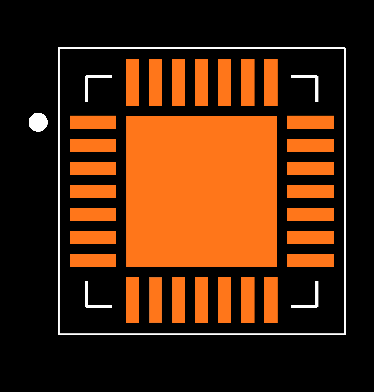
3D Models

Features
|
Feature |
Description |
|
Clinical-Grade ECG AFE |
High-resolution data converter with 15.5 bits effective
resolution and 5 µV P-P noise |
|
Improved Real-World CMRR |
Enhanced dry start capability with fully differential
input structure and CMRR > 100dB |
|
High Input Impedance |
High impedance > 500 MΩ for low common-to-differential
mode conversion |
|
Minimum Signal Attenuation |
Reduces signal loss at input during dry starts due to
high electrode impedance |
|
High DC Offset Range |
±650 mV (typical at 1.8V), compatible with various
electrodes |
|
High AC Dynamic Range |
65 mV P-P, prevents AFE saturation from motion or direct
electrode hits |
|
Longer Battery Life |
Consumes only 85 µW at 1.1V supply voltage |
|
Leads-On Interrupt Feature |
Allows microcontroller to remain in deep sleep mode until
valid lead condition is detected |
|
Lead-On Detect Current |
Low current of 0.7 µA (typical) |
|
Built-In Heart Rate Detection |
Onboard HR detection with interrupt feature, reducing
microcontroller processing load |
|
Robust R-R Detection |
Effective in high-motion environments with very low power
consumption |
|
Configurable Interrupts |
Allows microcontroller wake-up on every heartbeat,
reducing system power |
|
High Accuracy |
Enables extraction of more physiological data |
|
32-Word FIFO Buffer |
Supports waking up microcontroller every 256 ms with full
ECG acquisition |
|
High-Speed SPI Interface |
Facilitates quick data transfer |
|
Low Shutdown Current |
Consumes only 0.5 µA (typical) in shutdown mode |
Technical Specification
Here’s the technical specification table for the Maxim Integrated MAX30003CTI+.
|
Type |
Parameter |
|
Factory Lead Time |
9 Weeks |
|
Mounting Type |
Surface Mount |
|
Package / Case |
28-WFQFN Exposed Pad |
|
Surface Mount |
YES |
|
Number of Pins |
28 |
|
Packaging |
Tray |
|
Published |
2016 |
|
JESD-609 Code |
e3 |
|
Pbfree Code |
Yes |
|
Part Status |
Active |
|
Moisture Sensitivity Level (MSL) |
1 (Unlimited) |
|
Number of Terminations |
28 |
|
Type |
ECG Front End |
|
Terminal Finish |
Matte Tin (Sn) |
|
Max Operating Temperature |
70°C |
|
Min Operating Temperature |
0°C |
|
Applications |
Heart Rate Monitoring |
|
HTS Code |
8542.39.00.01 |
|
Terminal Position |
QUAD |
|
Terminal Form |
NO LEAD |
|
Peak Reflow Temperature (Cel) |
260 |
|
Number of Functions |
1 |
|
Supply Voltage |
1.8V |
|
Terminal Pitch |
0.5mm |
|
Time@Peak Reflow Temperature-Max (s) |
NOT SPECIFIED |
|
Base Part Number |
MAX30003 |
|
Temperature Grade |
COMMERCIAL |
|
Max Supply Voltage |
2V |
|
Min Supply Voltage |
1.2V |
|
Length |
5mm |
|
Height Seated (Max) |
0.8mm |
|
Width |
5mm |
|
REACH SVHC |
No SVHC |
|
RoHS Status |
ROHS3 Compliant |
Parts for Comparison
|
Part Number |
Manufacturer |
Package / Case |
Number of Pins |
Min Supply Voltage |
Supply Voltage |
Max Supply Voltage |
RoHS Status |
Mounting Type |
Peak Reflow Temperature |
|
MAX30003CTI+ |
Maxim Integrated |
28-WFQFN Exposed Pad |
28 |
1.2 V |
1.8 V |
2 V |
ROHS3 Compliant |
Surface Mount |
260 |
|
TLV320AIC23BIPWR |
Texas Instruments |
28-WFQFN Exposed Pad |
28 |
1.5 V |
3.3 V |
3.6 V |
ROHS3 Compliant |
Surface Mount |
260 |
|
TLV320AIC23BIRHD |
Texas Instruments |
28-TSSOP (0.173, 4.4mm) |
28 |
1.42 V |
- |
3.6 V |
ROHS3 Compliant |
Surface Mount |
260 |
|
SSM2603CPZ-REEL7 |
Analog Devices Inc. |
28-VFQFN Exposed Pad |
28 |
1.42 V |
- |
3.6 V |
ROHS3 Compliant |
Surface Mount |
260 |
|
TLV320AIC23BRHDR |
Texas Instruments |
28-VFQFN Exposed Pad |
28 |
1.42 V |
- |
3.6 V |
ROHS3 Compliant |
Surface Mount |
260 |
Functional Block Diagram
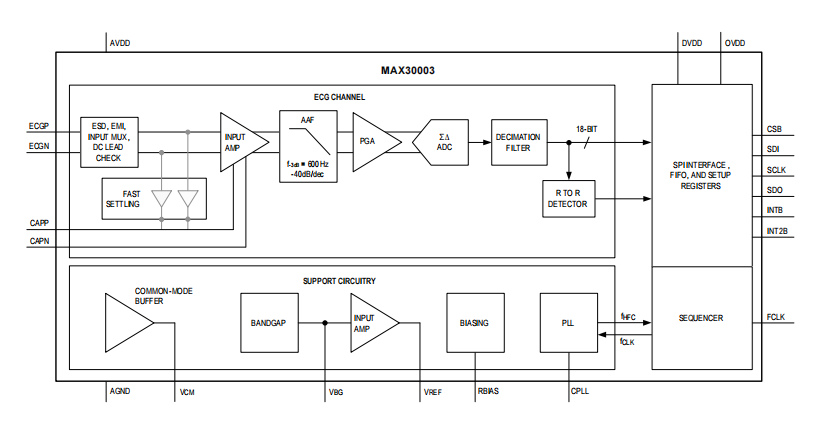
MAX30003 Circuit Integration
In ECG systems, electrodes affixed to the skin detect potential differences originating from the heart's subtle electrical activity. The MAX30003 exploits a dedicated biopotential channel to capture these signals. Through the strategic integration of numerous MAX30003 units in parallel, multi-lead configurations, such as those in a 3-lead Holter monitor, can be crafted. Typically, this arrangement necessitates the use of two units, leveraging signal processing to derive the third lead.
3-Lead Holter Monitor with MAX30003
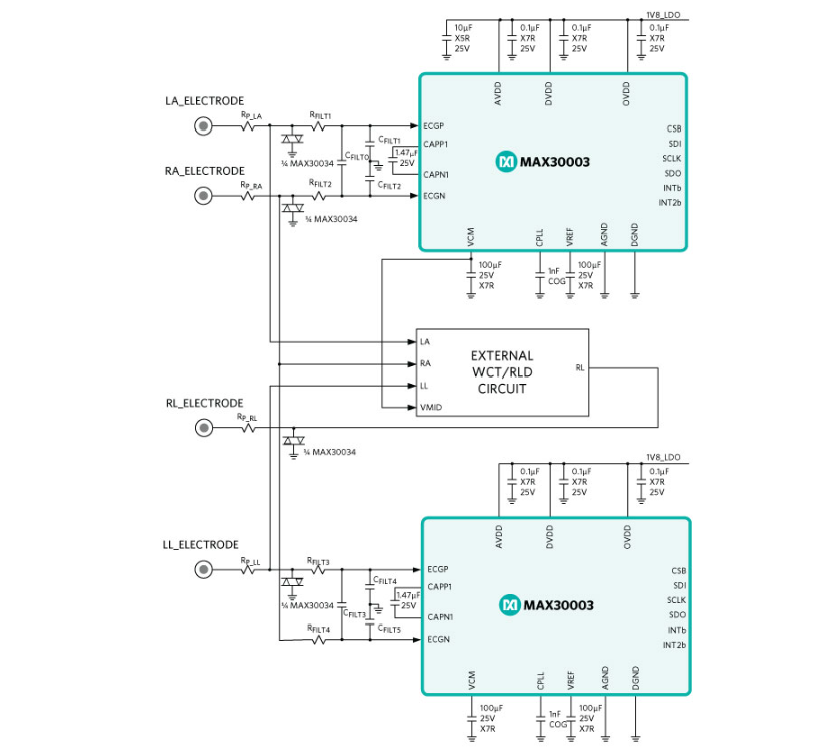
The MAX30003 is adept at supporting the architecture of a 3-lead Holter monitor. A Wilson Central Terminal (WCT) is a key component in this design, averaging potentials from three strategically placed electrodes, and aiding in noise minimization. The device is engineered to adeptly manage interference from common sources, like electrical lines, ensuring the extraction of a pristine signal devoid of noise.
In applications, a thoughtfully architected 3-lead system with precise electrode placement can substantially elevate the diagnostic process by offering a broader view of cardiac dynamics. Research indicates that a sturdy 3-lead configuration provides dependable continuous monitoring. Such a system is advantageous for the timely detection of arrhythmias.
Noise and Common-Mode Interference
ECG signal quality is frequently challenged by external noise, stemming from line interference, motion-related artifacts, and muscle contractions. The MAX30003 integrates cutting-edge filtering methodologies to counteract these disturbances. Its high Common-Mode Rejection Ratio (CMRR) and advanced differential input circuitry significantly curb common-mode noise, thereby elevating signal integrity. Utilizing an extra electrode for active noise cancellation further purifies the captured signal.
Experiences highlight that sustaining consistent signal quality benefits greatly from strategic electrode placement and adherence to recommended practices, such as ensuring a firm contact between electrodes and skin and advising relative stillness during ECG recordings. These measures are effective in reducing distortions and artifacts.
Body Potential Management
In portable ECG configurations, effective management of body potential is required to achieve precise readings. The MAX30003 adopts a dedicated right leg (RL) electrode to stabilize body potential, preventing electrical drift and ensuring amplifiers operate within their optimal range. In configurations lacking an RL electrode, the management of body potential can be facilitated through the use of programmable lead bias resistors.
The effective management of body potential can markedly affect measurement accuracy. Incorporating feedback loops and embedding adaptive algorithms to dynamically manage body potential is a viable approach to obtaining more accurate and consistent readings, especially in diverse physiological and environmental settings.
Typical Application Schematic
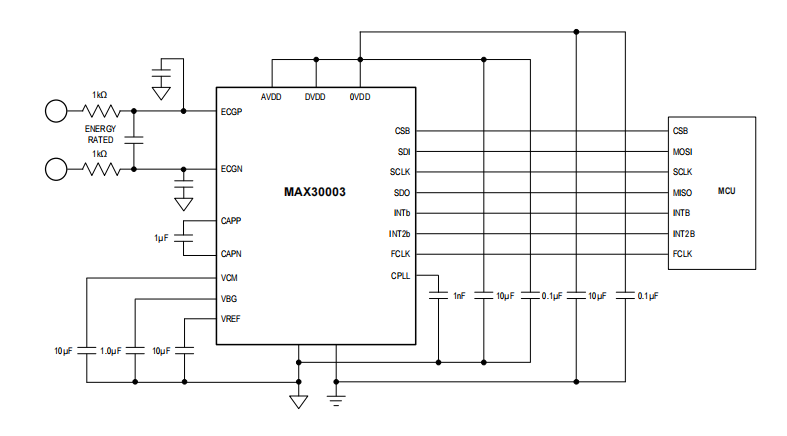
Use Case Circuit
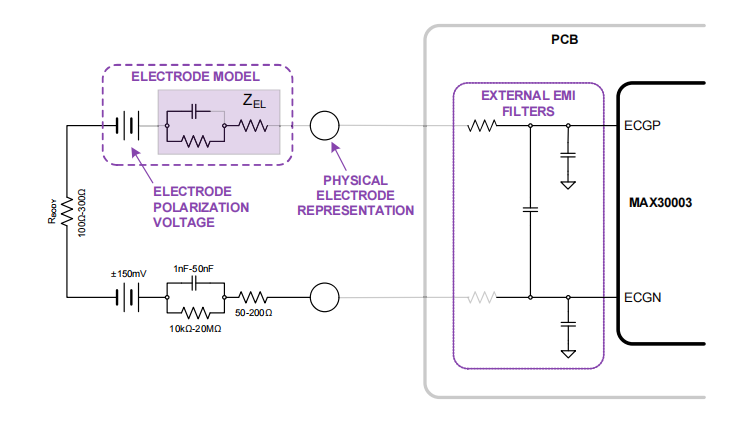
Comparing MAX30003 and AD8232 Specifications
|
Attribute |
MAX30003 |
AD8232 |
|
Base Product Number |
MAX30003 |
AD8232 |
|
Category |
Integrated Circuits (ICs) Specialized ICs |
Development Boards, Kits, Programmers Evaluation and
Demonstration Boards and Kits |
|
Manufacturer |
Maxim Integrated |
Analog Devices Inc. |
|
Series |
- |
- |
|
Package |
Tray |
Box |
|
Part Status |
Active |
Active |
|
Type |
ECG Front End |
Interface |
Popular Uses for the MAX30003 ECG Sensor
The MAX30003 is mainly well-suited for various applications, notably in health monitoring, fitness tracking, and bio-authentication. Exploring these domains highlights their tangible impact and advantages in everyday use.
Single-Lead Event Monitors for Observing Arrhythmia
In the world of arrhythmia observation, devices featuring the MAX30003 chip stand out for their ability to detect and monitor irregular heart rhythms. With the capability to identify anomalies early and precisely, these monitors are a dynamic tool for timely medical response. A range of modern healthcare devices incorporates event monitors for continuous heart rhythm tracking. They employ sophisticated algorithms to discern minor irregularities from more severe conditions, thereby bolstering patient care.
Wireless Patches for Remote Monitoring of Patients
The advent of wireless patches incorporating the MAX30003 is transforming remote patient surveillance. These devices enable uninterrupted ECG data sharing, empowering you to oversee cardiac health remotely. The technology proves advantageous for you, offering the comfort of reduced hospital visits. The reliability and precision these patches provide ensure that healthcare decisions are made promptly and with insight.
Fitness Trackers Heart Rate Monitors in Chest Bands
In fitness circles, chest bands with heart rate monitors that include the MAX30003 are extensively utilized. These instruments deliver accurate heart rate metrics, aiding athletes and fitness devotees in refining their training strategies. By interpreting biometric data, individuals can adapt their exercises to achieve targeted heart rate zones, thereby boosting the effectiveness and safety of their workouts. The utility and success of these monitors are well-established across different fitness environments.
ECG-Based Verification in Bio-Authentication Systems
Bio-authentication systems leveraging ECG-based verification offer a cutting-edge application of the MAX30003. By harnessing the distinctive electrical signals of a person's heart, these systems provide a robust and trustworthy form of identity verification. This method is gaining traction in high-security areas where conventional systems may fail. The individualized nature of ECG patterns ensures a formidable barrier against unauthorized access, reinforcing security protocols dramatically.
Manufacturer Overview
Maxim Integrated, now part of Analog Devices, holds a substantial role as a leading provider of analog and mixed-signal ICs. This integration positions the company to harness extensive industry knowledge, enabling the development of sophisticated and pioneering solutions. Rooted in a profound understanding of technological evolution and your needs, their innovations are guided by a blend of expertise and market intuition.
Within the automotive sphere, Maxim creates solutions that elevate vehicle dynamics, bolster safety measures, and enhance driver interactions. Their power management ICs are key in optimizing energy use, ensuring reliability even amidst challenging environments. By aligning advanced engineering with an exact understanding of automotive demands, Maxim actively contributes to the future of driving technology.
Datasheet PDF
TLV320AIC23BIPWR Datasheets:
TLV320AIC23BIRHD Datasheets:
SSM2603CPZ-REEL7 Datasheets:
TLV320AIC23BRHDR Datasheets:
About us
ALLELCO LIMITED
Read more
Quick inquiry
Please send an inquiry, we will respond immediately.
Frequently Asked Questions [FAQ]
1. In what areas is the MAX30003 predominantly utilized?
The MAX30003 has carved its niche in wearable ECG and heart rate monitoring gadgets, such as fitness trackers and medical apparatus. These tools leverage their precision in capturing cardiac distinctions, offering meaningful insights for those passionate about fitness and healthcare. This technology's induction into daily wearable gadgets enriches the capability to constantly observe vital health statistics, aiding in timely identification and improved management of heart-related concerns.
2. How efficient is the power consumption of the MAX30003?
Exhibiting exceptionally low power consumption, the MAX30003 proves its worth in battery-powered wearable gadgets. Its design secures extended operational periods, a feature greatly appreciated in devices required to operate for long durations without often recharging. This aspect is notably beneficial for individuals dependent on uninterrupted health tracking, facilitating consistent data gathering and interpretation.
3. What capabilities does the MAX30003 exhibit in detection?
The MAX30003 excels in detecting heart rates and delivering comprehensive ECG waveform information. Capturing exact cardiac patterns supports the identification and monitoring of numerous heart issues. Moreover, the ECG data it furnishes is used in crafting personalized fitness regimes and medical care plans. This highlights the device's wide-ranging applicability, spanning from wellness enhancements to clinical interventions.
4. Could you clarify the concept of soft power-up sequencing?
Soft power-up sequencing ensures safety by preventing adverse transients from reaching electrodes at startup. This protection fortifies sensitive electronic circuits and assures your safety. Such meticulous engineering emphasizes the device’s commitment to sustaining performance and trustworthiness without sacrificing safety.
5. How is the biopotential channel configured?
The biopotential channel is DC-coupled, allowing direct measurement of bodily electrical potentials. This channel is key in securing high-fidelity bio-signal data active for precise health observation and diagnostics. The DC-coupled feature ensures subtle bio-signals are accurately captured and interpreted, enhancing the reliability of data produced by the MAX30003.
6. What is the MAX30003’s temperature operation range?
The MAX30003 functions effectively within a temperature spectrum of 0°C to 70°C. This adaptability ensures steady performance across varied environmental scenarios, making it suitable for both indoor and outdoor setups. Whether in a clinical environment or during an outdoor run, the device sustains its precision and dependability, demonstrating its versatility and resilience.
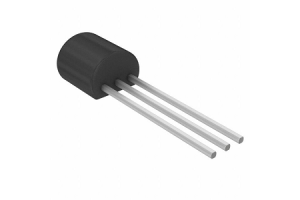
PN2222A: Datasheet, Applications, and Specifications
on November 7th
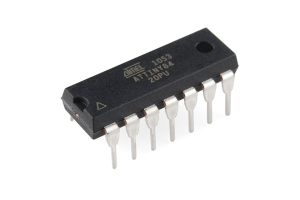
How ATTINY84 Microcontroller Powers Embedded Systems
on November 7th
Popular Posts
-

What is GND in the circuit?
on January 1th 2937
-

RJ-45 Connector Guide: RJ-45 Connector Color Codes, Wiring Schemes, R-J45 Applications, RJ-45 Datasheets
on January 1th 2499
-

Fiber Connector Types: SC Vs LC And LC Vs MTP
on January 1th 2089
-

Understanding Power Supply Voltages in Electronics VCC, VDD, VEE, VSS, and GND
on November 9th 1890
-

Comparison Between DB9 and RS232
on January 1th 1761
-

What Is An LR44 Battery?
Electricity, that ubiquitous force, quietly permeates every aspect of our daily lives, from trivial gadgets to life-threatening medical equipment, it plays a silent role. However, truly grasping this energy, especially how to store and efficiently output it, is no easy task. It is against this background that this article will focus on a type of coin cell battery that may seem insignificant on the...on January 1th 1712
-

Understanding the Fundamentals:Inductance Resistance, andCapacitance
In the intricate dance of electrical engineering, a trio of fundamental elements takes center stage: inductance, resistance, and capacitance. Each bears unique traits that dictate the dynamic rhythms of electronic circuits. Here, we embark on a journey to decipher the complexities of these components, to uncover their distinct roles and practical uses within the vast electrical orchestra. Inductan...on January 1th 1652
-

CR2430 Battery Comprehensive Guide: Specifications, Applications and Comparison to CR2032 Batteries
What is CR2430 battery ?Benefits of CR2430 BatteriesNormCR2430 Battery ApplicationsCR2430 EquivalentCR2430 VS CR2032Battery CR2430 SizeWhat to look for when buying the CR2430 and equivalentsData Sheet PDFFrequently Asked Questions Batteries are the heart of small electronic devices. Among the many types available, coin cells play a crucial role, commonly found in calculators, remote controls, and ...on January 1th 1551
-

What Is RF and Why Do We Use It?
Radio Frequency (RF) technology is a key part of modern wireless communication, enabling data transmission over long distances without physical connections. This article delves into the basics of RF, explaining how electromagnetic radiation (EMR) makes RF communication possible. We will explore the principles of EMR, the creation and control of RF signals, and their wide-ranging uses. The article ...on January 1th 1538
-

CR2450 vs CR2032: Can The Battery Be Used Instead?
Lithium manganese batteries do have some similarities with other lithium batteries. High energy density and long service life are the characteristics they have in common. This kind of battery has won the trust and favor of many consumers because of its unique safety. Expensive tech gadgets? Small appliances in our homes? Look around and you'll see them everywhere. Among these many lithium-manganes...on January 1th 1510


